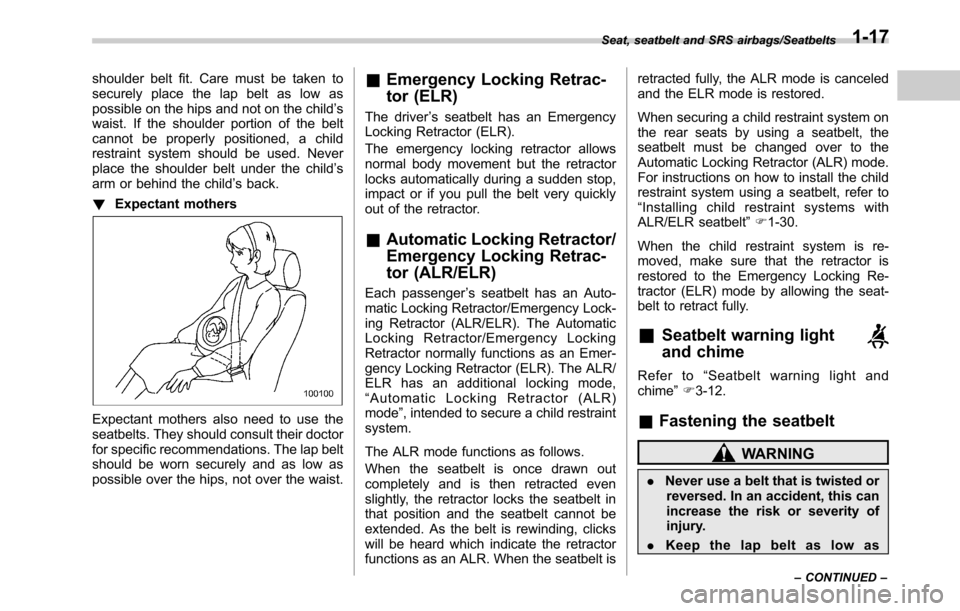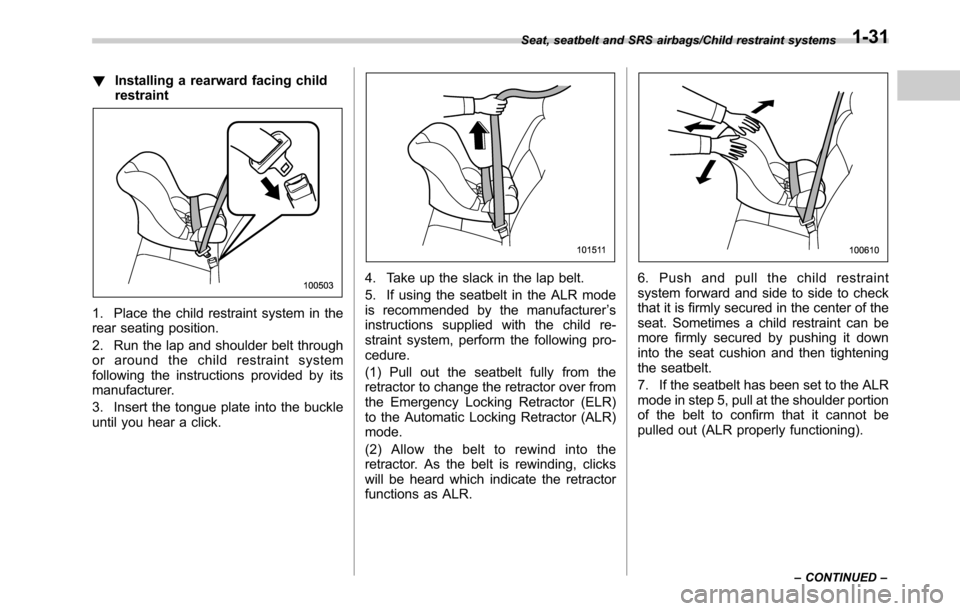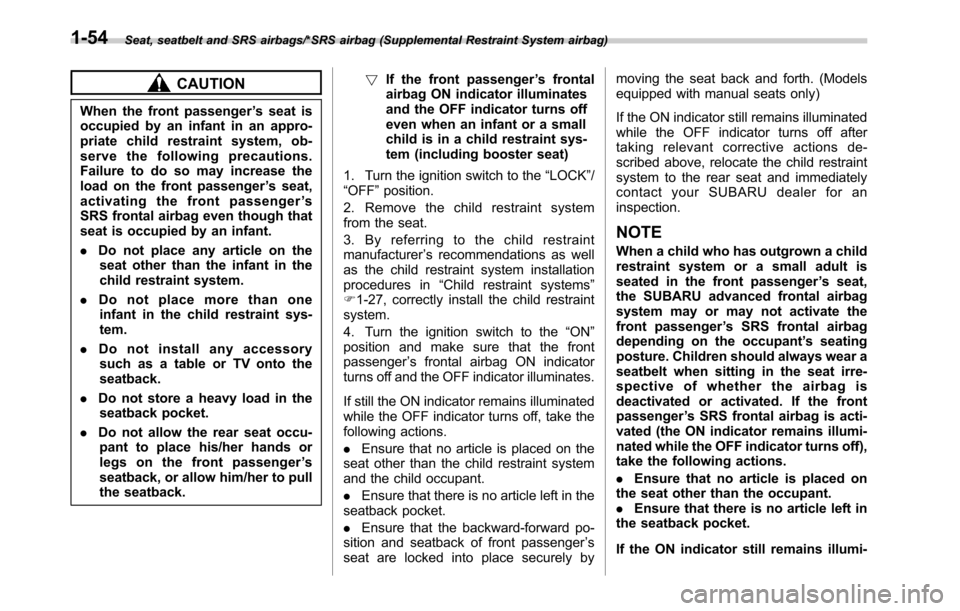ECO mode SUBARU OUTBACK 2016 6.G Owners Manual
[x] Cancel search | Manufacturer: SUBARU, Model Year: 2016, Model line: OUTBACK, Model: SUBARU OUTBACK 2016 6.GPages: 572, PDF Size: 21.79 MB
Page 23 of 572

&Combination meter
!U.S. spec. models (type A)
1) Tachometer (page 3-9)
2) ECO gauge (page 3-11)
3) Speedometer (page 3-8)
4) Temperature gauge (page 3-11)
5) Select lever/gear position indicator
(page 3-30)
6) Trip meter and odometer (page 3-8)
7) Fuel gauge (page 3-10)
–CONTINUED–
19
Page 24 of 572

!U.S. spec. models (type B)1) Tachometer (page 3-9)
2) ECO gauge (page 3-11)
3) Speedometer (page 3-8)
4) Temperature gauge (page 3-11)
5) Select lever/gear position indicator
(page 3-30)
6) Trip meter and odometer (page 3-8)
7) Fuel gauge (page 3-10)
20
Page 25 of 572

!Except U.S. spec. models (type A)1) Tachometer (page 3-9)
2) ECO gauge (page 3-11)
3) Speedometer (page 3-8)
4) Temperature gauge (page 3-11)
5) Select lever/gear position indicator
(page 3-30)
6) Trip meter and odometer (page 3-8)
7) Fuel gauge (page 3-10)
–CONTINUED–
21
Page 26 of 572

!Except U.S. spec. models (type B)1) Tachometer (page 3-9)
2) ECO gauge (page 3-11)
3) Speedometer (page 3-8)
4) Temperature gauge (page 3-11)
5) Select lever/gear position indicator
(page 3-30)
6) Trip meter and odometer (page 3-8)
7) Fuel gauge (page 3-10)
22
Page 29 of 572

Function settings
A SUBARU dealer can change the settings of the functions shown in the following table to meet your personal requirements. Contact
the nearest SUBARU dealer for details. Furthermore, some useful function settings are available using the multi information display.
For details, refer to“Menu screens”F3-38.
Item Function Possible settings Default setting Page
Alarm system Alarm system Operation/Non-operation Operation 2-28
Monitoring start delay time
(after closing doors)0 seconds/30 seconds 30 seconds 2-29
Impact sensor operation (only
models with shock sensors
(dealer option))Operation/Non-operation Non-operation 2-32
Map light/Dome light/Cargo
area light illuminationON/OFF OFF 2-28
Keyless access with push-
button start system
*1Audible signal*2ON/OFF ON 2-18, 2-47, 3-42
Audible signal volume*3Level 1 to 7 Level 5 2-18, 3-24, 3-42
Hazard warning flasher ON/OFF ON 2-18, 3-42
Door unlock selection (driver’s
door unlock)Driver’s door only/All doors Driver’s door only 2-17, 3-42
Door unlock selection (rear
gate unlock)Rear gate only, All doors Rear gate only
Remote keyless entry system Audible signal
*2ON/OFF ON 2-25, 2-26,
2-47, 3-42
Audible signal volume
*3Level 1 to 7 Level 5 2-25, 2-26, 3-42
Hazard warning flasher ON/OFF ON 2-25, 2-26, 3-42
Key lock-in prevention Key lock-in prevention Operation/Non-operation Operation 2-9
–CONTINUED–
25
Page 30 of 572

Item Function Possible settings Default setting Page
Defogger and deicer system Rear window defogger, out-
side mirror defogger and
windshield wiper deicerOperation for 15 minutes/
Continuous operationOperation for 15 minutes 3-54, 3-42
Map light/Dome light/Cargo
area lightOperation of map light/dome
light/cargo area light OFF de-
lay timerOFF/Short/Normal/Long Long 6-4, 3-42
Battery drainage prevention
functionBattery drainage prevention
functionOperation/Non-operation Operation 2-8
Auto on/off headlights Sensitivity of the operation of
the auto on/off headlightsMin/Low/Mid/Max Mid 3-44, 3-42
Windshield wiper Automatic headlight turn on
function that is linked with
wiper operationOperation/Non-operation Operation 3-44, 3-42
Auto dimmer cancel Sensitivity of the operation of
the auto dimmer cancelOFF/Min/Low/Mid/Hi/Max Mid 3-48
Welcome lighting function Welcome lighting function
(when approaching)OFF/30 seconds/60 seconds/
90 seconds30 seconds 3-42, 3-44
Welcome lighting function
(when exiting)OFF/30 seconds/60 seconds/
90 seconds30 seconds
Reverse gear interlocked rear
wiperReverse gear interlocked rear
wiper operationOperation/Non-operation U.S.-spec. models: Non-operation
Other models: Operation3-53
One-touch lane changer Operation of the one-touch
lane changerOperation/Non-operation Operation 3-48
*1: If equipped
*2: This setting also works as the ON/OFF setting of the power rear gate buzzer for starting operation. However, you cannot change the warning buzzer
setting for a detecting jam, etc.
*3: The audible signal volume cannot be set under level 5 for the warning chime.
26
Page 47 of 572

shoulder belt fit. Care must be taken to
securely place the lap belt as low as
possible on the hips and not on the child’s
waist. If the shoulder portion of the belt
cannot be properly positioned, a child
restraint system should be used. Never
place the shoulder belt under the child’s
arm or behind the child’s back.
!Expectant mothers
Expectant mothers also need to use the
seatbelts. They should consult their doctor
for specific recommendations. The lap belt
should be worn securely and as low as
possible over the hips, not over the waist.
&Emergency Locking Retrac-
tor (ELR)
The driver’s seatbelt has an Emergency
Locking Retractor (ELR).
The emergency locking retractor allows
normal body movement but the retractor
locks automatically during a sudden stop,
impact or if you pull the belt very quickly
out of the retractor.
&Automatic Locking Retractor/
Emergency Locking Retrac-
tor (ALR/ELR)
Each passenger’s seatbelt has an Auto-
matic Locking Retractor/Emergency Lock-
ing Retractor (ALR/ELR). The Automatic
Locking Retractor/Emergency Locking
Retractor normally functions as an Emer-
gency Locking Retractor (ELR). The ALR/
ELR has an additional locking mode,
“Automatic Locking Retractor (ALR)
mode”, intended to secure a child restraint
system.
The ALR mode functions as follows.
When the seatbelt is once drawn out
completely and is then retracted even
slightly, the retractor locks the seatbelt in
that position and the seatbelt cannot be
extended. As the belt is rewinding, clicks
will be heard which indicate the retractor
functions as an ALR. When the seatbelt isretracted fully, the ALR mode is canceled
and the ELR mode is restored.
When securing a child restraint system on
the rear seats by using a seatbelt, the
seatbelt must be changed over to the
Automatic Locking Retractor (ALR) mode.
For instructions on how to install the child
restraint system using a seatbelt, refer to
“Installing child restraint systems with
ALR/ELR seatbelt”F1-30.
When the child restraint system is re-
moved, make sure that the retractor is
restored to the Emergency Locking Re-
tractor (ELR) mode by allowing the seat-
belt to retract fully.
&Seatbelt warning light
and chime
Refer to“Seatbelt warning light and
chime”F3-12.
&Fastening the seatbelt
WARNING
.Never use a belt that is twisted or
reversed. In an accident, this can
increase the risk or severity of
injury.
.Keep the lap belt as low as
Seat, seatbelt and SRS airbags/Seatbelts
–CONTINUED–1-17
Page 61 of 572

!Installing a rearward facing child
restraint
1. Place the child restraint system in the
rear seating position.
2. Run the lap and shoulder belt through
or around the child restraint system
following the instructions provided by its
manufacturer.
3. Insert the tongue plate into the buckle
until you hear a click.
4. Take up the slack in the lap belt.
5. If using the seatbelt in the ALR mode
is recommended by the manufacturer’s
instructions supplied with the child re-
straint system, perform the following pro-
cedure.
(1) Pull out the seatbelt fully from the
retractor to change the retractor over from
the Emergency Locking Retractor (ELR)
to the Automatic Locking Retractor (ALR)
mode.
(2) Allow the belt to rewind into the
retractor. As the belt is rewinding, clicks
will be heard which indicate the retractor
functions as ALR.6. Push and pull the child restraint
system forward and side to side to check
that it is firmly secured in the center of the
seat. Sometimes a child restraint can be
more firmly secured by pushing it down
into the seat cushion and then tightening
the seatbelt.
7. If the seatbelt has been set to the ALR
mode in step 5, pull at the shoulder portion
of the belt to confirm that it cannot be
pulled out (ALR properly functioning).
Seat, seatbelt and SRS airbags/Child restraint systems
–CONTINUED–1-31
Page 64 of 572

Seat, seatbelt and SRS airbags/Child restraint systems
For additional instructions, refer to“To p
tether anchorages”F1-38.
12. To remove the child restraint system,
press the release button on the seatbelt
buckle and allow the belt to retract
completely. The belt will return to the
ELR mode.
NOTE
When the child restraint system is no
longer in use, remove it and restore the
ELR function of the retractor. That
function is restored by allowing the
seatbelt to retract fully.
&Installing a booster seat
WARNING
.Child restraint systems and seat-
belts can become hot in a vehicle
that has been closed up in sunny
weather; they could burn a small
child. Check the child restraint
system before you place a child
in it.
.Do not leave an unsecured child
restraint system in your vehicle.
Unsecured child restraint sys-
tems can be thrown around in-
side of the vehicle in a sudden
stop, turn or accident; they can
strike and injure vehicle occu-
pants as well as result in serious
injuries or death to the child.
CAUTION
When you install a child restraint
system, follow the manufacturer’s
instructions supplied with it. After
installing the child restraint system,
check to ensure that it is held
securely in position. If it is not held
tight and secure, the danger of your
child suffering personal injury in the
event of an accident may be in-
creased.
1. Place the booster seat in the rear
seating position and sit the child on it. The
child should sit well back on the booster
seat.
2. Run the lap and shoulder belt through
or around the booster seat and the child
1-34
Page 84 of 572

Seat, seatbelt and SRS airbags/*SRS airbag (Supplemental Restraint System airbag)
CAUTION
When the front passenger’s seat is
occupied by an infant in an appro-
priate child restraint system, ob-
serve the following precautions.
Failure to do so may increase the
load on the front passenger’s seat,
activating the front passenger’s
SRS frontal airbag even though that
seat is occupied by an infant.
.Do not place any article on the
seat other than the infant in the
child restraint system.
.Do not place more than one
infant in the child restraint sys-
tem.
.Do not install any accessory
such as a table or TV onto the
seatback.
.Do not store a heavy load in the
seatback pocket.
.Do not allow the rear seat occu-
pant to place his/her hands or
legs on the front passenger’s
seatback, or allow him/her to pull
the seatback.!If the front passenger’s frontal
airbag ON indicator illuminates
and the OFF indicator turns off
even when an infant or a small
child is in a child restraint sys-
tem (including booster seat)
1. Turn the ignition switch to the“LOCK”/
“OFF”position.
2. Remove the child restraint system
from the seat.
3. By referring to the child restraint
manufacturer’s recommendations as well
as the child restraint system installation
procedures in“Child restraint systems”
F1-27, correctly install the child restraint
system.
4. Turn the ignition switch to the“ON”
position and make sure that the front
passenger’s frontal airbag ON indicator
turns off and the OFF indicator illuminates.
If still the ON indicator remains illuminated
while the OFF indicator turns off, take the
following actions.
.Ensure that no article is placed on the
seat other than the child restraint system
and the child occupant.
.Ensure that there is no article left in the
seatback pocket.
.Ensure that the backward-forward po-
sition and seatback of front passenger’s
seat are locked into place securely bymoving the seat back and forth. (Models
equipped with manual seats only)
If the ON indicator still remains illuminated
while the OFF indicator turns off after
taking relevant corrective actions de-
scribed above, relocate the child restraint
system to the rear seat and immediately
contact your SUBARU dealer for an
inspection.
NOTE
When a child who has outgrown a child
restraint system or a small adult is
seated in the front passenger’s seat,
the SUBARU advanced frontal airbag
system may or may not activate the
front passenger’s SRS frontal airbag
depending on the occupant’s seating
posture. Children should always wear a
seatbelt when sitting in the seat irre-
spective of whether the airbag is
deactivated or activated. If the front
passenger’s SRS frontal airbag is acti-
vated (the ON indicator remains illumi-
nated while the OFF indicator turns off),
take the following actions.
.Ensure that no article is placed on
the seat other than the occupant.
.Ensure that there is no article left in
the seatback pocket.
If the ON indicator still remains illumi-
1-54